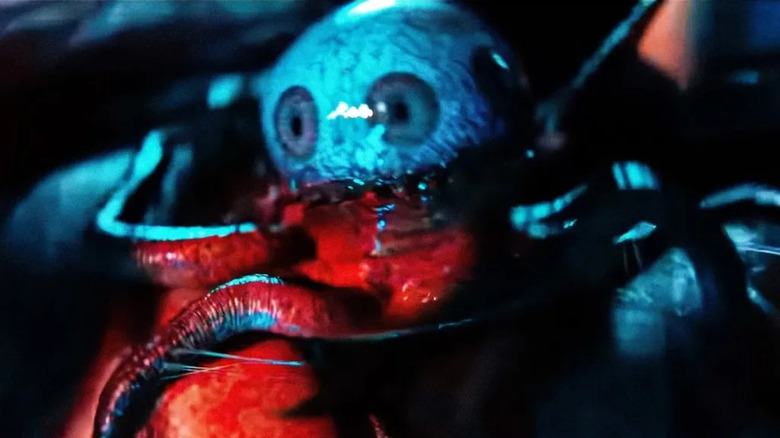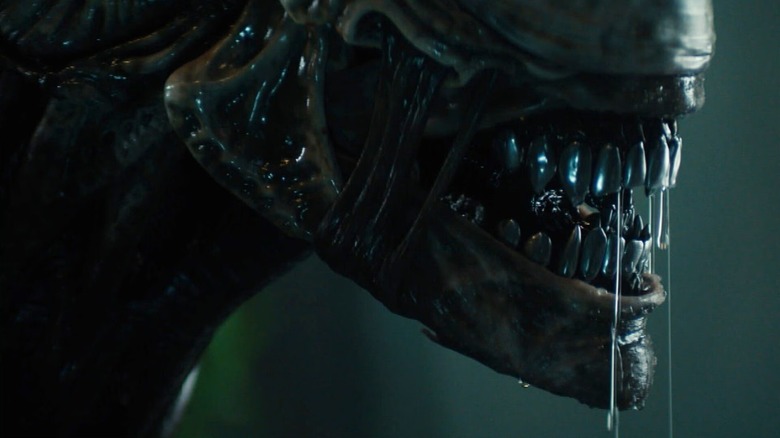The Xenomorph Isn't Even The Most Dangerous Creature In Alien: Earth
When you hear the word "alien" in reference to the film series begun by Ridley Scott in 1978, you probably think of one specific kind of alien: the Xenomorph. The ultra-violent extraterrestrial predator with two mouths and acid for blood is one of the most iconic creatures in the history of cinema, thanks to a timeless design from the legendary H. R. Giger. While there have been many different variants of the Xenomorph over the years, every major film in the franchise has a representative of the species at its center — save for maybe "Prometheus," the only film in the series not to carry the "alien" name.
"Alien: Earth" follows that trend with plenty of Xenomorph screen time, but the FX show also expands the title of "Alien" beyond that single species. The Maginot, the Weyland-Yutani ship that crash-lands in Prodigy territory at the start of the show, is actually carrying five different alien species: the Xenomorph, a kind of giant flying bug that forms hives and fires powerful acid, a giant plant, a species of blood-sucking leeches, and a tiny walking eyeball that can take over and control other lifeforms.
Through the first half of the show, it's still the Xenomorph that gets the spotlight, but in episode 5, "In Space, No One...," we get a closer look at some of the other species as well via flashbacks to their escape aboard the Maginot. And here's the thing: In this one instance, the Xenomorph isn't actually the most dangerous alien. That honor belongs to the real star of "Alien: Earth" — that dastardly little eyeball.
Alien: Earth's eyeball monster is scarier than the Xenomorph
The appeal and fear factor of the Xenomorph both come from its status as the ultimate predator — a creature that represents little more than hunger, violence, and raw strength. That's a perfectly fine pitch for a monster movie, especially when the circumstances around the creature are so mysterious. The franchise has spent decades decoding bits and pieces of the Xenomorph lore, but none of that has ever really changed the alien into a different thing than what it always was.
Eyeball guy, referred to on the show as "Species 64," seems to be completely different. There are suggestions earlier in the show that it might possess higher intelligence, but episode 5 shows this in action via the creature's elegant plan to escape its captivity aboard the Maginot. Though the facehuggers get free due to sabotage, Species 64 makes its own escape, and it does so in a way that betrays its true smarts.
While science officer Chibuzo (Karen Aldridge) is conducting tests on one of the other species — the blood parasites — eyeball man watches closely. One of the parasites manages to climb to the top of its tank and unlock the opening from the inside, suggesting that species also possesses pretty advanced intelligence. But what's more freaky is that Species 64 sees this, recognizes it as a net good for itself, and actively distracts Chibuzo so that the parasite can successfully escape and pollute her food and water. The ability to not only see an external circumstance as specifically advantageous, but to then sort out a way to assist it indirectly, is beyond the level of reasoning we've seen from Xenomorphs, and it makes Species 64 very, very dangerous.
Would Alien: Earth ever let another species take the spotlight?
If this were an original IP, you might assume after episode 5 that the Xenomorph is more of a ruse, covering for the show's real extraterrestrial threat: Mr. Eyeball. Okay, maybe only I would think that, but because this is the "Alien" franchise, that thought never really crossed my mind. You don't make a "Terminator" show about some new kind of robot that isn't a Terminator. Fans show up to see the thing they know, so it's likely that Species 64 will remain more of a background threat throughout the remainder of the season.
That said, there's a ton of potential here. It's interesting to see multiple parasite species in "Alien: Earth," each of which behaves in a different way. The blood parasites, Xenomorphs, and Species 64 all require other organisms to truly thrive, and it makes you wonder what nefarious schemes Weyland-Yutani has in mind for the creatures.
As for the eyeball guy specifically, we still know very little about the extent of its abilities. In the body of a human it's mostly acted as a zombie, but could it learn to mimic human speech? Could it hide itself more effectively and masquerade as one of us? Hopefully, "Alien: Earth" will make some more time to explore those questions alongside your regularly scheduled Xenomorph shenanigans.


